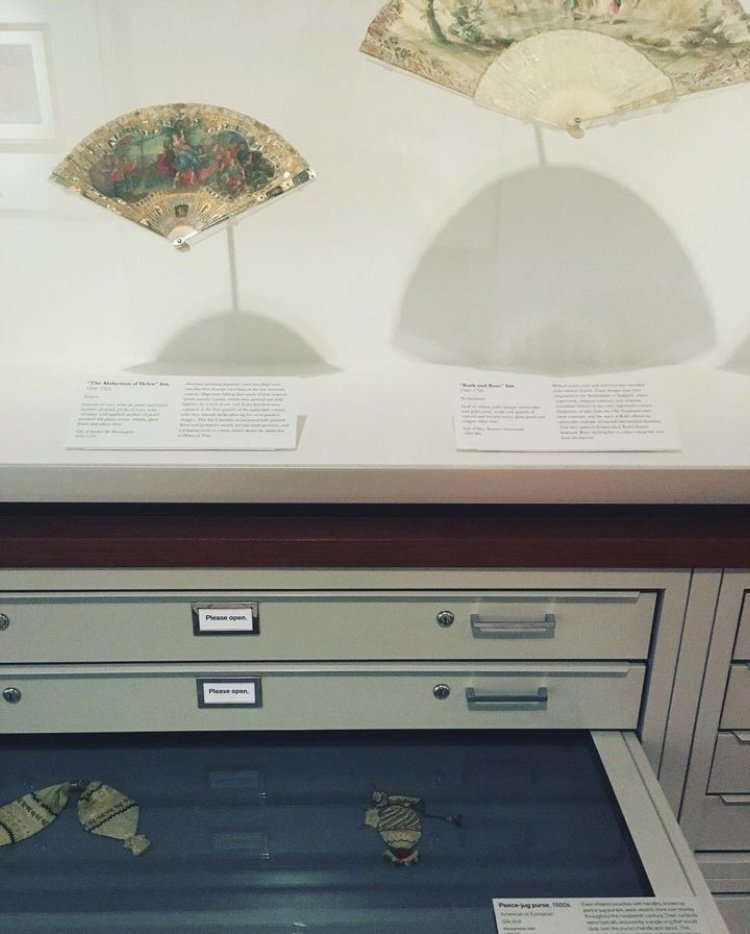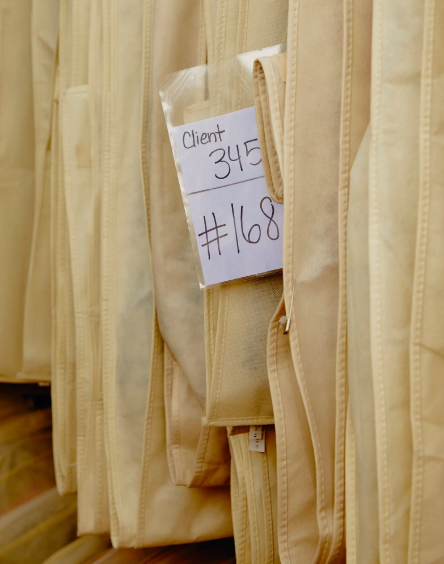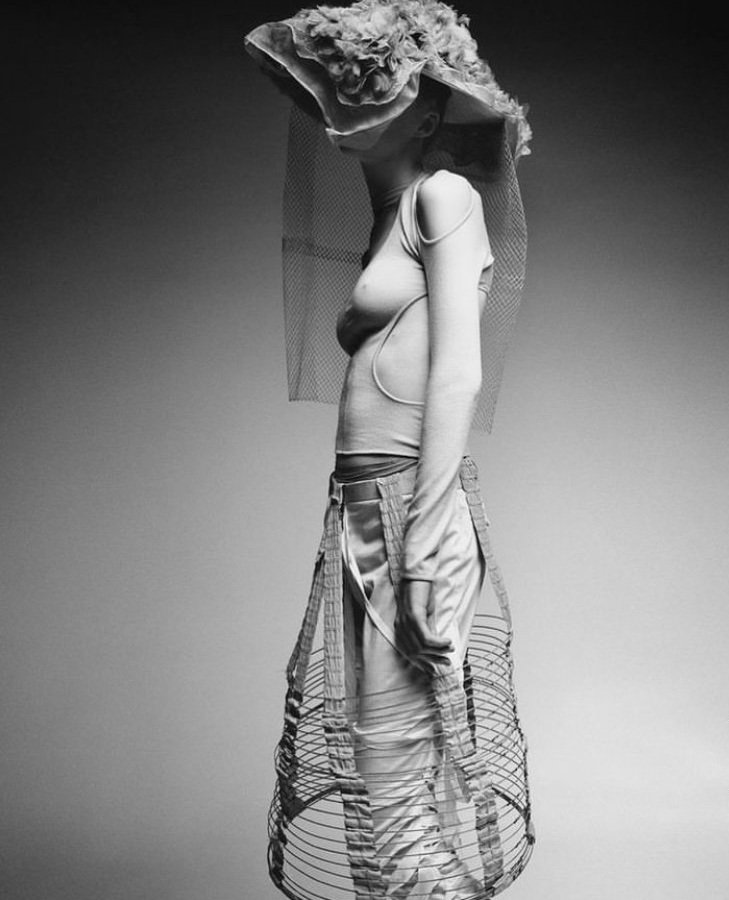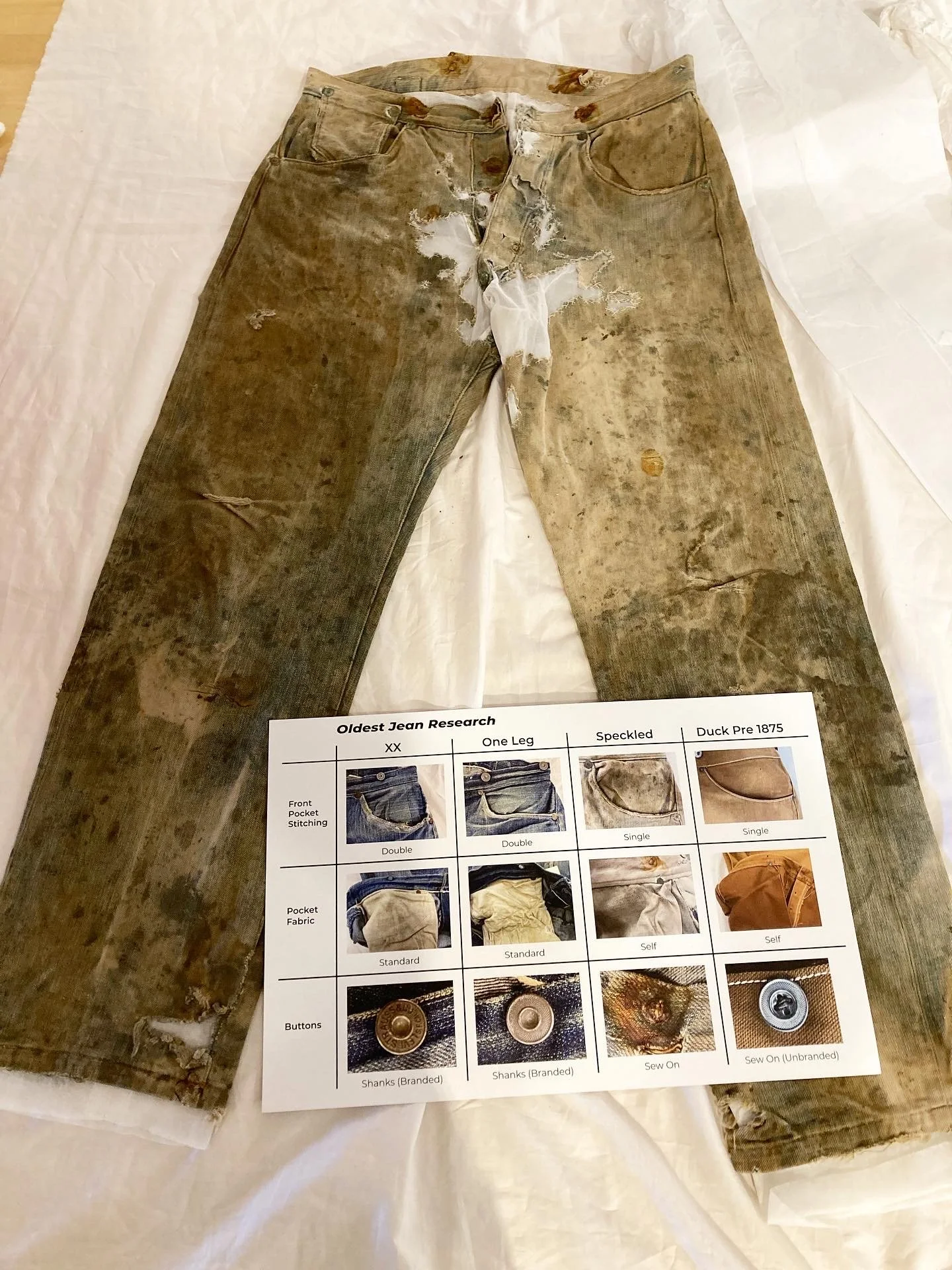Archives
Helen Uffner Vintage Clothing
Helen Uffner Vintage Clothing has been renting authentic period clothing and accessories to the entertainment and fashion industries for over 43 years.
Helen Uffner Vintage Clothing includes meticulously racked collection comprised of authentic 1860’s‑1980’s women’s, men’s and children’s clothing and accessories.
"You Say You Want a Revolution? Records and Rebels 1966-1970" major exhibition at the Victoria & Albert Museum explored the era-defining significance and impact of the late 1960s, expressed through some of the greatest music and performances of the 20th century alongside fashion, film, design, and political activism. With five vintage Levi’s® garments on loan from the Levi Strauss & Co. Archives, the exhibit offers a rare chance to see how the people who wore Levi’s® personified the energy of an era.
A pair of late-1960s Levi’s® 505 Jeans with customized patches and trimmings and a part of the Levi & Strauss Co. Archives; Featured in the "You Say You Want a Revolution? Records and Rebels 1966-1970" exhibition at the Victoria & Albert Museum.
These "Prison Pants" date from 1979 to 2013 when an inmate in a Northern California prison illustrated his Sta-Prest White Levi’s® jeans with felt tip and ballpoint pens during his thirty-year incarceration. Part of the Levi Strauss & Co. Archives' permanent collection and the "Levi Strauss: A History of American Style" exhibition.
WindowsWear Museum at Berkeley College’s first installation from Coach.
WindowsWear has the world’s largest digital archive of fashion window displays, that will be periodically featured in the museum. WindowsWear’s archive dates back to 1931, the same year Berkeley College was founded.

The making of "School of Fashion" at Milk Gallery featuring illustrations from the Parsons Fashion Archive (The New School Archives and Special Collections).
The "School of Fashion" at Milk Gallery featuring copies of Anna Sui illustrations from the Parsons Fashion Archive (The New School Archives and Special Collections).
UOVO is a storage facility that features climate-controlled storage and viewing rooms that meet or exceed the archive standards of the world’s leading museums, along with installation, packing, crating and transportation services. Image credit: UOVO Nicholas Calcott.

Behind-the-scenes footage of the archiving studio, The Wardrobe.
The Wardrobe for UOVO; Image credit: Nicholas Calcott.
The Wardrobe archiving and curation studio. Image credit: The Wardrobe.
PVH Archives featuring Calvin Klein collection.

andARCHIVE, a fashion library and private showroom specializing in rare Japanese designers. Image credit: Cataloging 1990s Comme des Garçons.
A fashion editorial with a provided wardrobe from andARCHIVE. Image credit: Suited Magazine Issue No. 2 Autumn/Winter 2015; Styled by Jessica Willis and photographed by Nicholas Alan Cope.
Comme des Garçons, Issey Miyake, and Yohji Yamamoto archival pieces from andARCHIVE. Image credit: Suited Magazine Issue No. 2 Autumn/Winter 2015; Styled by Jessica Willis and photographed by Nicholas Alan Cope.
Yohji Yamamoto and Junya Watanabe for Comme des Garçons archival pieces from andARCHIVE. Image credit: Suited Magazine Issue No. 2 Autumn/Winter 2015; Styled by Jessica Willis and photographed by Nicholas Alan Cope.
"Scrapbook" photographed by Steven Meisel. Image credit: Italian Vogue September 2015. Styled by Karl Templer; Wardrobe provided by andARCHIVE.
Parodi Costume Collection supports an active curatorial program of exhibitions, publications, and loans through its preservation, conservation, and technical research of the thousands of objects in the collection, spanning from the 18th century to the present.
Parodi Costume Collection offers conservation education, providing lectures for specialized groups, students, and the public.
FIDM Museum Study Collection is a hands-on resource for education and inspiration that includes women's, men's, and children's garments, and accessories dating from the 18th century to the present. Image credit: Pucci pieces part of the FIDM Museum collections.
"Publicity photo featuring a collared white faille dress from the Resort and Early Spring 1955 ready-to-wear collection by Sophie Originals" in the Kellen Design Archives part of The New School Archives and Special Collections.
"Designing the Second Skin: Giorgio di Sant’Angelo 1971-1991" at Arnold and Sheila Aronson Galleries, Sheila C. Johnson Design Center 2012. The Sant’Angelo works were originally donated to the Metropolitan Museum of Art by Parsons faculty member Martin Price, Sant-Angelo’s design assistant and partner, who has been an instrumental force in keeping Sant’Angelo’s spirit alive.
"Designing the Second Skin: Giorgio di Sant’Angelo 1971-1991" at Arnold and Sheila Aronson Galleries, Sheila C. Johnson Design Center 2012. The works on view are drawn from the Parsons Fashion Archive—a collection of nearly 10,000 garments, including a number of pieces donated to Parsons by the Costume Institute at The Metropolitan Museum of Art.
The Museum at FIT launched the crowdsourced project, Wearing Memories, in November 2017 to help tell the story of clothes. The public was encouraged to share their stories and photos of garments that held special meaning. More than 300 memories were shared with the museum, some of which were included in the exhibition and others published on the museum’s Tumblr page. Image credit: My father's 1983 Pulsion cable-knit sports sweater.
Marlene Dietrich in the first image part of the 1980 George Hurrell permanent collection. UCR ARTS includes two collecting institutions: the California Museum of Photography and the Sweeney Art Gallery. The CMP collection is comprised of approximately 500,000 objects and includes photographic prints, negatives, archives, books, and technology. The Sweeney Art Gallery holds the university’s art collection, which encompasses paintings, photography, sculpture, video, and artists’ books.
"Woman wearing dress and hat standing near two women in a window" [Date not indicated] from the 1840-1900 digital collections. The CMP's photography collection exceeds 20,000 images that were created by over 1,000 photographers. The collection is complemented by historic processes including daguerreotypes, calotype negatives, ambrotypes, tintypes, and cyanotypes.
Drawers featuring a selection of artworks from the Fine Arts Museums of San Francisco's costume and textile collection.
Garde Robe by UOVO pioneered the luxury wardrobe management and stores some 40,000 items owned by clients. About half are from fashion brands. Image credit: Peter Garritano for The New York Times.
A green-fur-trimmed coat from Marina Moscone’s resort 2022 line archived at Garde Robe by UOVO. Image credit: Peter Garritano for The New York Times.
Garde Robe is a luxury wardrobe storage and preservation service. Pieces that need to be hung are put inside garment bags made of polypropylene, a breathable plastic. Image credit: Peter Garritano for The New York Times.
Located at the de Young, the George and Marie Hecksher Textile Conservation Center manages the preservation, conservation, and scientific study of the permanent textile collection, which currently numbers more than 14,000 pieces. The textile collection contains monumental tapestries, archaeological fragments, contemporary fiber art, and clothing and accessories.
Lesbian Herstory Archives. Photo by Saskia Scheffer.
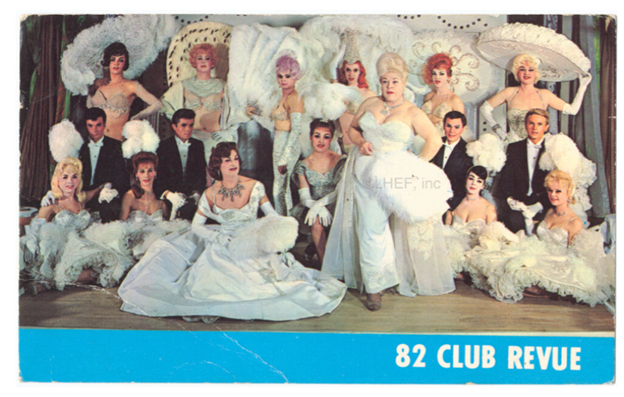
"82 Club Revue," 1940-1949. The Lesbian Herstory Archives exists to gather, preserve and provide access to records of Lesbian lives and activities. It serves to uncover and document herstory previously denied by patriarchal historians in the interests of the culture that they served. The existence of the Archives enables current and future generations to analyze and reevaluate the Lesbian experience.
Victorian Corset provided by Helen Uffner Vintage Clothing. Image credit: Display Copy magazine, Issue II: World In Progress. Styled by Gabrielle Marceca and photographed by Jon Ervin.
Display Copy is a fashion magazine and recommence platform devoted to "Expertly Curated Vintage," upcycled and thrifted fashion. Victorian Hoop-Skirt provided by Helen Uffner Vintage Clothing. Image credit: Styled by Gabrielle Marceca and photographed by Jon Ervin.
"It's Personal" cover story featuring a 1950s Cone Bra styled with a Tiered Petticoat from Helen Uffner Vintage Clothing. The editorial focuses on collecting as an act of totemic significance and of metamorphosis where Fashion Editor Gabrielle Marceca selects treasured pieces from the storied collections of four devoted fashion collectors-cum-archivists. Image credit: Styled by Gabrielle Marceca and photographed by Jon Ervin.
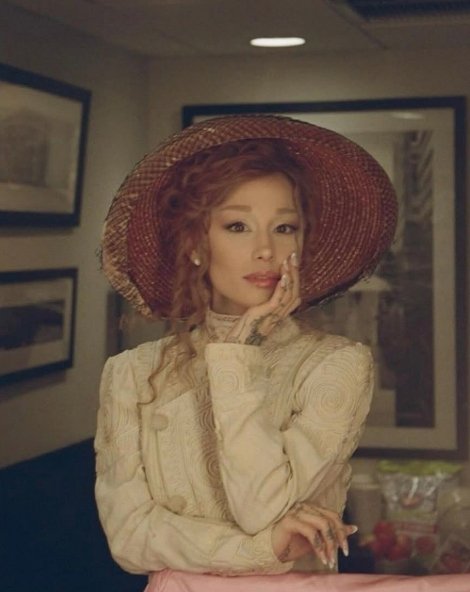
Ariana Grande in an Edwardian Ensemble from the Helen Uffner Vintage Clothing collection for SNL (Saturday Night Live). Wardrobe/ costume design by Tom Broecker and photographed by Katia Temkin.
"Members of San Francisco Ballet at the Golden Gate Bridge," 1957. For over 75 years, the Museum of Performance + Design has been diligently collecting and preserving the history of the performing arts in the San Francisco Bay Area. With a vast collection of over 3.5 million items, it serves as a prominent living record that spans from the era of the Gold Rush to the present day, capturing the rich tapestry of the performing arts of San Francisco and beyond.
The San Francisco Historical Society exists to uncover, preserve, and present, in engaging ways, the colorful and diverse history of the city from its earliest days to the present. The collection of historical artifacts from the worlds of dance, music, and theater, including costumes, programs, performance videos, and other unique memorabilia, was part of the inaugural collaboration with the Museum of Performance + Design.
Founded by community-based artists and activists in 1994, Loco Bloco (LB) provides BIPOC youth with transformational arts experiences to foster dialogue, engagement and unity between diverse cultures in Bay Area communities. Based on frameworks that emerged in Latin America of artistic creation as an emancipatory process, LB empowers youth to embrace the cultural legacies of their ancestors, overcome discrimination and create positive change.
1873 XX Waist Overalls, "9Rivet," are an accurate representation of the brand's first pair of jeans in the Levi Strauss & Co. Archives. Conserved by Paul O'Neil, Design Director of Levi's Vintage Clothing, he preserved the garment's "ghost"- the story and history embedded in its imperfections and how it would've been worn on the body. Using translucent fabric (most likely nylon net) and wide cross-stitches for easy removal, the decision was to prioritize preserving the item's history and enhance the visibility of its wearable design.
Nicole K. Rivas is a fashion archive professional in collections care management, sustaining best practices within storage procedures, preservation services, and conservation efforts.
As a self-proclaimed “fashion archaeologist,” she continues to discover and study diversely used artifacts that were lived in, displayed, and experienced. By applying archaeological thinking to the contemporary world, her most recent practices aim to decode what these vestiges may reveal about the present or past fashioning zeitgeist.
Clients
The Wardrobe (Tom Ford; Gabriela Hearst)
Garde Robe by UOVO (The Row; Dualstar Entertainment)
Levi Strauss & Co. Archives
Coach Archives
The New School Archives and Special Collections
Parodi Costume Collection
WindowsWear Museum
California Museum of Photography
andARCHIVE
Helen Uffner Vintage Clothing
Community Archives
San Francisco Historical Society
Lesbian Herstory Archives
SEM (Society for Ethnomusicology) Archiving Special Interest Group
Loco Bloco SF



























!["Woman wearing dress and hat standing near two women in a window" [Date not indicated] from the 1840-1900 digital collections. The CMP's photography collection exceeds 20,000 images that were created by over 1,000 photographers. The collection is com](https://images.squarespace-cdn.com/content/v1/63267e8fe37f66705b41d4a7/940aac6d-b4ac-48a5-b200-4b706ec12c0f/1988.0023.0039.jpg)
